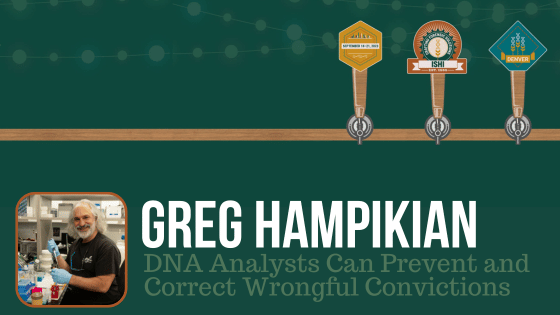The National Registry of Exonerations reported that misleading forensic evidence is a prominent factor in wrongful convictions. Because DNA evidence resonates with jurors, even small mistakes have large effects. For example, when male DNA is reported in a “sperm fraction”—even though no sperm are present—the profile is referred to as “sperm DNA” by lawyers and investigators. Another example is when a DNA comparison is reported “inconclusive” even though a negative likelihood ratio favors the defendant (but doesn’t meet the lab’s reporting standards). Analyst’s reports are used by prosecutors, defense lawyers and accused people (often in jail) to make life-changing decisions regarding charges, pleas and offers. At trial, DNA analysts may face ineffective or misleading questioning that can deny jurors critical information.
In his presentation at ISHI 34 this year, Greg will use case examples, expert testimony and exonerations to review common DNA practices that risk wrongful conviction. As co-director of the Idaho Innocence Project, the presenter has helped free more than 40 people from wrongful convictions, published research on bias in DNA interpretation, and offers suggestions to prevent and correct DNA errors. We chatted with him to get to know him a bit better and to preview his upcoming presentation.
What is one key learning that attendees will be able to take back to the lab and implement based on your presentation?
DNA analysts can undo wrongful convictions that were based on outdated interpretation methods and language.
Do you think anything in your presentation will surprise the audience? If so, can you give us a teaser?
The absence of evidence, IS the evidence of absence in DNA testing. Male saliva samples show enrichment in differentially extracted “Sperm Fractions.” “Cervical Swabs” carry DNA from outside the vagina into it. Analysts who consult privately on out-of-state cases improve the system, assure equal access to crime lab experts, and help prevent adversarial allegiances. Inconclusive results can demonstrate bias.
Who in the audience will benefit most from your presentation? If someone was interested in learning more about your topic, do you have recommendations for resources?
The desired audience is foremost the DNA analysts, but also prosecutors, judges, lawyers, journalists and students.
Forensic DNA and serology problems, 2021 talk for the Texas Criminal Defense Lawyers Association (TCDLA), https://youtu.be/Wvo5P6n83eM.
What inspired you to seek out a career in the forensic field?
Studying wrongful convictions.
If you could go back in time, what advice would you give to your younger self as you were starting out?
Time is your friend, there is only one deadline, and we all make it on time.
If you had to pick one thing, what do you enjoy most about your job?
Thinking and laughing with my colleagues and students.
If you currently work in the lab, or have in the past, what’s the weirdest thing you’ve ever collected DNA from?
The sewers of Boise.
If you’ve attended ISHI in the past, what do you most enjoy about coming to the conference?
My favorite thing is making new friends and seeing old ones. My advice, socialize, ask older folks what they do, get their contact info. and send them a quick note. At every talk or poster, think of one question to ask–and ask it!
What is one item on your bucket list? Have you checked if off yet?
Working in Africa. Not yet!
What’s one thing that others may not know about you?
I can get any child to eat vegetables, the secret is to let them demonstrate the strength they gain by pushing you across the room. The harder you fall, the more they eat!
WOULD YOU LIKE TO SEE MORE ARTICLES LIKE THIS? SUBSCRIBE TO THE ISHI BLOG BELOW!
SUBSCRIBE NOW!


